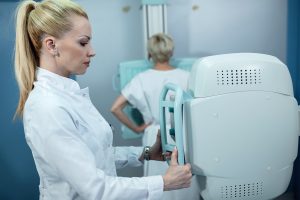Key Takeaways

-
New technology is making mammograms more effective at detecting breast cancer. Technologies such as digital breast tomosynthesis and AI-assisted diagnostic algorithms are increasing the precision of their diagnoses while improving patient outcomes. These innovations support radiologists in their efforts to interpret results as accurately as possible.
-
Thanks to new imaging techniques that provide better clarity with lower radiation exposure, patient screenings are now safer and more reliable. These changes come on the heels of work to create a better experience for all who are receiving screening.
-
New screening guidelines now include adjustments to recommended starting ages and breast density levels. These changes are based on new science about breast cancer risks, and they’re designed to improve early detection efforts.
-
These new FDA regulations are disrupting the status quo at mammography facilities nationwide. They ensure high quality and price transparency for patients who need care.
-
Retiring older mammography units and replacing them with newer diagnostic equipment. Together, these changes are intended to increase the convenience and effectiveness of breast care services for patients nationwide.
-
Improved insurance coverage along with clearer recommendations for care after a mammogram are opening doors to important breast health services. This allows people to make the most informed decisions about their health.
The latest technology aims to make mammograms more accurate and comfortable. New 3D imaging systems (called digital breast tomosynthesis) produce sharper images with more detail. These new technologies have given medical professionals the power to identify smaller abnormalities at much earlier stages.
AI-powered tools are helping radiologists analyze scans faster than before and are flagging potential areas of concern. Mammograms using lower radiation doses are available, providing safer screenings without sacrificing the quality of images.
Patient-friendly innovations like curved compression paddles have helped make the procedure much more comfortable for patients. These innovations are all aimed at increasing rates of early detection.
Their advocacy focuses on streamlining diagnostic processes and developing a more patient-centered continuum of breast health care. These recent updates are major leaps forward, both in technological advancement and prevention tactics.
Recent Advancements in Mammogram Technology
The landscape of mammogram technology has improved tremendously in 2025, with more advanced tools available for early detection and diagnosis. These improvements lead to more accurate screenings and better patient experience and outcomes.
1. New Imaging Techniques for Clarity
Today, advanced imaging technologies offer improved, more precise images of breast tissue. 3D mammography—also known as tomosynthesis—has quickly become the gold standard for early detection. 3D imaging takes pictures from different angles of the breast, which is more accurate than the standard two-dimensional mammograms.
SmartCurve tech eliminates false alarms and unnecessary callbacks by 40%. This breakthrough also detects 20-40% more invasive cancers, greatly reducing the chance of missed diagnoses. At Jefferson Radiology, we use advanced imaging technology to make your appointment shorter and more comfortable.
They hold themselves to rigorous standards, accredited by the American College of Radiology. Recent research has also shifted the guidelines for screening, recommending that those at high risk start getting mammograms earlier.
Revised protocols for dense breast tissue provide personalized evaluations, delivering accurate outcomes for a wider patient population. The FDA has also finalized new regulations to enforce these practices, creating an additional layer of nationwide consistency and patient safety.
2. Digital Breast Tomosynthesis Updates
Digital breast tomosynthesis (DBT) is the newest technology being used in mammography to improve detection rates. As more centers are moving units to where people are, and closer to their homes, screenings are becoming increasingly convenient to obtain.
Each of these units now come with new high-tech diagnostic modules, giving radiologists more precise images to look at for more accurate evaluations. As ownership transitions and facility names change, these moves have been shared openly to keep the public’s trust, keeping quality of service always the top concern.
3. Enhanced AI-Assisted Diagnostics
Artificial intelligence (AI) has completely changed the landscape of mammogram analysis, serving as a game-changing asset for radiologists. AI systems quickly and accurately identify abnormalities, lowering the risk of human error while speeding up diagnoses.
Patients need to be empowered to speak up about their health history and concerns with their providers. This interagency communication makes clear that AI tools should be designed to improve personalized care.
4. Improved Radiation Safety Measures
These new protocols keep patients safer by reducing radiation exposure without affecting image quality. In-person, regular mammograms are still crucial for catching disease early, when it is most treatable and survival rates are highest.
These improvements ensure that screenings are safer and more effective, further solidifying their important place in preventive care.
Changes in Mammogram Guidelines and Rules
With these newly adopted guidelines and rules, the fight for equitable access, accurate interpretation, and overall better understanding of breast health continues. These changes are intended to improve patient experiences while encouraging necessary early detection and follow up care.
1. Updated Screening Age Recommendations
The guidelines now recommend beginning routine mammograms at age 40 instead of 50, reflecting new studies that show earlier detection improves outcomes. This change recognizes the value to patients of detecting abnormalities earlier, especially for patients who have a hereditary risk or family history of breast cancer.
For younger people with high-risk factors, supplemental screenings such as MRIs can be used alongside mammograms. This approach aims to ensure that those at greater risk receive the most effective monitoring and care possible.
2. Adjustments to Breast Density Screenings
Women with dense breast tissue may find mammograms harder to interpret. The 2023 MQSA Final Rule expands on this by requiring facilities to notify patients if they have dense breasts.
This gives patients the power to advocate for supplemental screening, whether that be ultrasound or 3D mammography, with their healthcare providers. Clear, consistent language in all notifications today means that patients are more aware of their breast density and the risk that comes with it.
3. New FDA Regulations for Facilities
Fighting for patients’ health and safety, the FDA’s new regulations shine a light on transparency. Facilities are required to retain mammograms and reports for no less than 5 years, though state law may mandate a longer duration.
Specifically, suspicious findings should be communicated directly to patients within 7 days to minimize any potential delay in care. Compliance enforcement through annual inspections ensures adherence to the Mammography Quality Standards Act (MQSA).
Facility and Service Updates
Changes to mammography services are happening very quickly. Facilities and protocols are undergoing major changes to deliver more streamlined and regulated practices. These revisions cover the enhancement of operational procedures, use of upgraded diagnostic equipment, and adherence to regulatory requirements per the Mammography Quality Standards Act (MQSA).
Below, we parse out the key updates.
1. Relocation Processes for Mammography Units
The logistics of relocating mammography units require significant planning to prevent disruption. Facilities undergoing transitions should be mindful that MQSA regulations still apply and all devices should fulfill FDA premarket authorization requirements to be used for mammography.
Mammograms and reports should always remain available. Facilities are required to transmit or otherwise make available requested copies within 15 calendar days of the request. You have to keep permanent record for various lengths of time.
For active patients, hold for five years, and for patients with no additional mammograms, hold for ten years.
2. Adding New Equipment or Modules
Facilities are able to incorporate the new modules once they have submitted an MQSA application. Upon submission, this shall consist of the medical physicist’s passing Equipment Evaluation results submitted to the American College of Radiology (ACR).
This makes ADA compliance easy and ready to use right away. By adopting advanced imaging technologies and committing to highest standard of diagnostic accuracy, you show you care, that you choose smart.
3. Guidelines for Facility Name Changes
Documentation of any name change is necessary to keep MQSA certification and have smooth day-to-day operations. Patient records and equipment compliance are not impacted so long as the facility meets state and federal guidelines.
4. Ownership Transitions and Their Impact
Changes in ownership require disclosure and compliance in accordance with MQSA regulations. Personnel records of former employees, retained for two years, should be available during inspections.
Regular compliance with recordkeeping and device standards helps to ensure that high-quality mammography services are provided without interruption.
Preparing for a Mammogram
Knowing what to expect when preparing for a mammogram can help ensure the process is as simple and comfortable as possible. Dedicate a few minutes to familiarize yourself with what you should do in advance of your appointment. Provide the correct information to your healthcare provider to make your experience seamless and productive.
Here’s what to expect, along with our complete guide on how to prepare for a mammogram and feel confident for your screening.
Steps to follow before your appointment
Preparation is key to maximizing both your comfort and your mammogram results, but there are a few small yet important steps to take before your appointment. For example, you should refrain from using deodorant, lotion, or powder on your breasts or underarms on the day of the exam. These products can leave residues that may then inhibit the imaging process.
If you typically consume caffeine, cutting back for a few days can help lessen breast tenderness, particularly if you’re sensitive to caffeine. Timing is a big part, too. Make an appointment for the week after your period. Your breasts will be less tender at that time, making the process more comfortable.
If you’re concerned about discomfort afterward, pack some OTC pain medication. Ibuprofen or acetaminophen will make you more comfortable should you need them. Don’t forget that the actual procedure is typically under 30 minutes total. Taking the time to prepare will ensure that you feel calm and ready when you arrive for your appointment.
Key information to share with your provider
Providing your provider with as much specific health information as possible leads to a more tailored, effective screening. Inform them if you’ve observed any changes in your breasts, such as lumps or tenderness. Feel free to bring up any other unusual skin changes you might have noticed, too.
If you have a direct family history of breast cancer, discuss this. Remember to share all other risk factors you may have as well! These important pieces of information allow your provider to understand your personal risk and decide what kind of mammogram is best for you.
Providers also appreciate transparency regarding any previous mammograms or biopsies. For instance, if you have a history of abnormal results, this knowledge can help inform where they should direct their attention during the screening. Callbacks for further testing are made in approximately 10% of instances.
The overwhelming majority—about 8 to 10%—actually lead to biopsy recommendations. Being open and honest with your technologist will make sure the experience is as comfortable as possible.
Importance of Mammograms for Breast Health
Mammograms have historically been the gold standard in breast health, providing women with a proven approach to early detection of breast abnormalities. Then in 2025, new guidelines were released. They’ve recently recommended that women at average risk of breast cancer begin routine screenings at 40 rather than 50.
This change mirrors the increasing body of evidence showing that the benefits of earlier detection, including the role it can have in improving outcomes, are substantial. Nearly 1 in 8 women will be diagnosed with breast cancer in her lifetime. That’s why these changes are aimed at putting proactive care first.
Thanks to modern advancements, such as 3D mammography, the screening process has completely changed. Unlike conventional techniques, this technology produces detailed, layered images of breast tissue, providing a clearer picture for a more accurate evaluation.
At Precision Imaging Centers, an experienced team of specialists use cutting-edge technology to provide accurate, reliable results. They take a compassionate approach to their care. The procedure, while it does require temporary compression of the breast between two plates, is completed in a few minutes.
Few women will feel more than mild discomfort, but the advantages greatly exceed any short-lived feelings. Personalized screening plans come into focus in 2025, focusing recommendations on personal risk factors.
By providing the right technology and information, this approach gives women confidence to take charge of their health. By uniting the best in modern technology with a personalized approach to care, mammograms remain one of the most powerful tools we have for protecting breast health.
Accessing Innovative Breast Care Services
We envision the mammography landscape in 2025 to be one that truly lays the groundwork for better access, more accurate readings, and better post-screening care. Together with advancements in technology and federal initiatives, these innovations are revolutionizing breast care services. These changes are intended to accommodate a variety of needs and provide equitable access to all women.
New insurance coverage options
Insurance policies are making big strides to cover and reimburse for these advanced breast imaging techniques. The Find It Early Act seeks to eliminate out-of-pocket costs for screenings and diagnostic imaging, particularly benefiting women with dense breast tissue or higher cancer risks. This is especially important because 36% of women over 40 have heterogeneously dense breasts, which makes cancers harder to detect.
Despite these advancements, pitfalls in the form of varying insurance coverage still present a significant barrier. Addressing these disparities ensures that innovations like 3D mammography are accessible to all women, supporting earlier detection and better outcomes.
Post-mammogram care recommendations
In the wake of a mammogram, tailored care plans are increasingly important and complex than ever. Women who have dense breast tissue struggle with disproportionately higher false positive and missed detection rates. Consequently, they often require follow-up imaging or referrals.
Recent FDA requirements that mandate that facilities inform women of their breast density status help women make more informed decisions about their health and treatment options. When this transparency is paired with more personalized follow-up care, providers can take steps to mitigate anxiety and therefore create an improved overall patient experience.
Understanding your mammography report
Mammography reports must now provide a description of breast density each time, in accordance with new FDA regulations. This disclosure is especially important for women with very dense breasts, a subgroup that makes up 7% of the population.
Mobile mammography units are an essential tool for accessing care to underserved rural and low-income communities. They help make sure women who would otherwise miss screenings receive these important health services. Together, these initiatives improve early detection and close the cancer care equity gap.
Conclusion
Mammograms are changing for the better with innovative technologies, new guidelines and a more patient-centric approach. These improvements make screenings quicker, more informative, and a lot less intimidating. As technology improves, making imaging clearer than ever, updated guidelines make sure your screenings are tailored to you. Facilities are getting on board too, offering enhanced services and comforts to make your experience a more positive one.
It’s never been easier to take charge of your breast health. Finding cancers early with regular mammograms means more treatment options and more time. Keeping up with new technology and services will better equip you to make the most confident decisions about your health.
Consult your physician, discuss alternatives, and make an appointment for your next mammogram. It’s a simple precautionary move for the sake of your health and to ensure you go about your life with confidence.
Frequently Asked Questions
What are the latest advancements in mammogram technology for 2025?
By 2025, mammograms include AI-assisted imaging, ensuring both speed and accuracy in results. These new 3D imaging techniques are more effective at detecting cancers in dense breast tissue, which helps with more thorough, early diagnoses.
Have mammogram guidelines changed recently?
Specifically, some guidelines have recently reversed course and begun recommending that average-risk women start getting mammograms at age 40. This frequency can vary based on your unique health history – discuss with your doctor to understand how often you should be getting screened.
How can I prepare for my mammogram appointment?
For ease of exam, wear a two-piece ensemble and avoid deodorants, perfumes, or powders, which can affect imaging. If you have previous mammograms, bring them with you if possible.
Why are mammograms essential for breast health?
Mammograms are the best way to detect breast cancer early, sometimes up to three years before any symptoms show. Early detection allows for more aggressive treatment and better survival rates, which is why they are such a key preventive weapon.
What facility updates should I know about in 2025?
Most breast care centers have the capability of providing same-day results and newer, more comfortable imaging equipment. Many offer mobile mammography units to bring care closer to home for easier access.
How can I access innovative breast care services?
Find accredited facilities that provide the most advanced screening technologies such as 3D mammograms or AI imaging. Look for online reviews and check certifications to make sure you’re receiving the best care possible.
Are mammograms safe for long-term use?
Yes, mammograms do use low-dose radiation, and they are safe for routine screenings. The benefits of early detection by mammography far outweigh any negligible harms related to the procedure.


